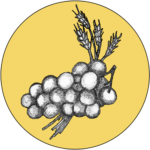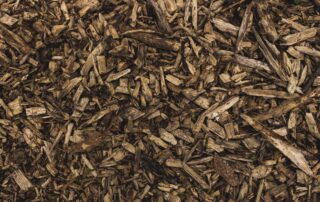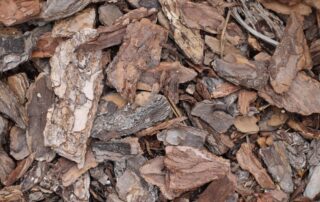 Pillar: Sacramental Ecology
Pillar: Sacramental Ecology
Laudato Si’ Action Plan Goals: Adoption of Simple Lifestyles, Ecological Spirituality
 Pillar: Sacramental Ecology
Pillar: Sacramental Ecology
Laudato Si’ Action Plan Goals: Adoption of Simple Lifestyles, Ecological Spirituality
Group: Teens, Young Adults and Able-Bodied Adults
Learning Goals:
- Experience using discarded organic material from one land process as mulch in another land area.
- Reflect on and discuss the process of living a virtuous life through analogies with creation.
Materials Needed: Wheelbarrows; shovels or pitchforks; work gloves; wood mulch, leaf mulch or pine needles. (NOTE: The lesson is most effective when wood mulch is chipped by the group, or leaf mulch and pine needles are gathered by the group.)
General Outline of Experience
- Begin with an excerpt from the “Prayer for the Earth” at the end of Laudato Si, n. 246: “Bring healing to our lives, that we may protect the world and not prey on it, that we may sow beauty, not pollution and destruction.”
- Introduce the idea of virtue, and how virtue can supplant vice in our lives. Vice is a kind of pollution or littering. “A virtue is a habitual and firm disposition to do the good” (Catechism of the Catholic Church, n. 1803).
- Laudato Si’, n. 217: “Living our vocation to be protectors of God’s handiwork is essential to a life of virtue; it is not an optional or a secondary aspect of our Christian experience.”
- Gather the necessary tools: wheelbarrows, shovels, pitchforks, gloves.
- Gather mulch if that is included in the activity.
- Clear the ground. The group prepares the space to be mulched. This means making sure it is clear of weeds, dead branches and leaves, and rocks.
- Leader shows the materials and tools and how they are properly used.
- Lead up to key point: Everything has its role in benefitting the garden; there is no such thing as “waste” in nature. Excess wood, leaves, and pine needles can be re-purposed to keep down weeds and also to enrich the soil. Mulch is made from unwanted or discarded organic materials such as wood, leaves, or pine needles. Wood mulch comes from trees and branches after clearing trails, yards, and woodland. Leaf mulch forms from piles of leaves after raking. Pine needles can be collected from under pine and other coniferous trees, or from gardens or lawns where they will choke out grass and other plants. We take what was unwanted in one area to benefit another area.
- Each person is given a pitchfork and/or shovel, wheelbarrow, and work gloves.
- Participants fill the wheelbarrow with mulch, using the pitchfork or shovel. (For larger groups, participants may be broken into teams of two or three people.)
- Participants transport the mulch to the desired location and unload the wheelbarrow with care, paying attention to the environment and the plants near where they are mulching, taking care not to dump the mulch on top of the plants.
- Participants mindfully place the mulch around the growing plants and fill in open spaces with a layer at least one inch deep. They use their hands as necessary to smooth and spread the mulch.
- During the work period, the following questions could be raised:
- What skills does this activity teach us?
- Is this something you can do at home?
- How might doing this together be different from doing it alone?
- The leader can also encourage the participants to think of spiritual analogies for the mulching process.
- What are the messy aspects of our lives that need to be cleared out and “neatened” up?
- How do we re-purpose and re-use experiences or aspects of ourselves or others that may be considered “out of place” or “unfinished” or “unwanted”?
- What parts of our lives need a good layer of mulch?
- Gather for a snack
- Participants gather and assess the mulching. Everyone reviews the garden as a whole and works together to fill any missing spaces.
- If the project is being done for a certain person or leader of an organization (such as a school or parish), he or she is brought in to approve of the finished project.
- Participants clean out wheelbarrows and brush off shovels and pitchforks. All tools and equipment are put away neatly.
- Any “misfired” mulch is cleaned up to the best of the participants’ abilities and put in the garden.
As a group, discuss some of the following questions:
- What was difficult about mulching?
- What was rewarding about mulching?
- After this experience, what does this Gospel passage from Matthew 12:13-45 mean to you? Do you see any relationship with the mulching process? “When an impure spirit comes out of a person, it goes through arid places seeking rest and does not find it. Then it says, ‘I will return to the house I left.’ When it arrives, it finds the house unoccupied, swept clean and put in order. Then it goes and takes with it seven other spirits more wicked than itself, and they go in and live there. And the final condition of that person is worse than the first. That is how it will be with this wicked generation.”
- What spiritual analogies came to mind? Some thoughts that could be brought into the discussion include:
- In the spiritual life we clear the garden of our souls from sin, then fill that space with virtue. Sin is the disorder of a good desire. We conquer sin and foster virtue by harnessing the good desire and rooting out the disordered thought or act.
- How might the repetitive acts of mulching be similar to forming virtue?
- How can others help me to be more virtuous? How can I help others?
- If my life was a garden, how many vices (weeds) are there, and how many virtues (good plants)?
Cross-references to related experiential activities: Restoring Land, Garden Work




